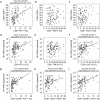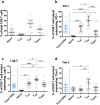Exhaustion of Activated CD8 T Cells Predicts Disease Progression in Primary HIV-1 Infection
- PMID: 27415828
- PMCID: PMC4945085
- DOI: 10.1371/journal.ppat.1005661
Exhaustion of Activated CD8 T Cells Predicts Disease Progression in Primary HIV-1 Infection
Abstract
The rate at which HIV-1 infected individuals progress to AIDS is highly variable and impacted by T cell immunity. CD8 T cell inhibitory molecules are up-regulated in HIV-1 infection and associate with immune dysfunction. We evaluated participants (n = 122) recruited to the SPARTAC randomised clinical trial to determine whether CD8 T cell exhaustion markers PD-1, Lag-3 and Tim-3 were associated with immune activation and disease progression. Expression of PD-1, Tim-3, Lag-3 and CD38 on CD8 T cells from the closest pre-therapy time-point to seroconversion was measured by flow cytometry, and correlated with surrogate markers of HIV-1 disease (HIV-1 plasma viral load (pVL) and CD4 T cell count) and the trial endpoint (time to CD4 count <350 cells/μl or initiation of antiretroviral therapy). To explore the functional significance of these markers, co-expression of Eomes, T-bet and CD39 was assessed. Expression of PD-1 on CD8 and CD38 CD8 T cells correlated with pVL and CD4 count at baseline, and predicted time to the trial endpoint. Lag-3 expression was associated with pVL but not CD4 count. For all exhaustion markers, expression of CD38 on CD8 T cells increased the strength of associations. In Cox models, progression to the trial endpoint was most marked for PD-1/CD38 co-expressing cells, with evidence for a stronger effect within 12 weeks from confirmed diagnosis of PHI. The effect of PD-1 and Lag-3 expression on CD8 T cells retained statistical significance in Cox proportional hazards models including antiretroviral therapy and CD4 count, but not pVL as co-variants. Expression of 'exhaustion' or 'immune checkpoint' markers in early HIV-1 infection is associated with clinical progression and is impacted by immune activation and the duration of infection. New markers to identify exhausted T cells and novel interventions to reverse exhaustion may inform the development of novel immunotherapeutic approaches.
Conflict of interest statement
We were unable to contact Stephen Hickling, listed as an author of this paper, to confirm his involvement in the latest version. The corresponding author, John Frater, has therefore supplied the information regarding his contribution to the manuscript and his competing interests and it is correct to the best of his knowledge. The authors are not aware of any other potential conflict of interest associated with this manuscript.
Figures





References
-
- Feeney ME, Tang Y, Roosevelt KA, Leslie AJ, McIntosh K, Karthas N, et al. Immune escape precedes breakthrough human immunodeficiency virus type 1 viremia and broadening of the cytotoxic T-lymphocyte response in an HLA-B27-positive long-term-nonprogressing child. J Virol. 2004;78: 8927–8930. - PMC - PubMed
-
- Goulder P, Price D, Nowak M, Rowland-Jones S, Phillips R, McMichael A. Co-evolution of human immunodeficiency virus and cytotoxic T-lymphocyte responses. Immunol Rev. 1997;159: 17–29. - PubMed
-
- Kiepiela P, Leslie AJ, Honeyborne I, Ramduth D, Thobakgale C, Chetty S, et al. Dominant influence of HLA-B In mediating the potential co-evolution of HIV and HLA. Nature. 2004;432: 769–774. - PubMed
-
- Leslie AJ, Pfafferott KJ, Chetty P, Draenert R, Addo MM, Feeney M, et al. HIV evolution: CTL escape mutation and reversion after transmission. Nat Med. 2004;10: 282–289. - PubMed
Publication types
MeSH terms
Substances
Grants and funding
LinkOut - more resources
Full Text Sources
Other Literature Sources
Medical
Research Materials

